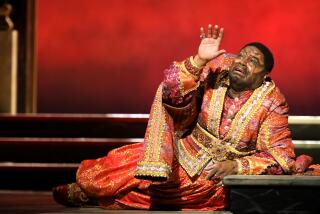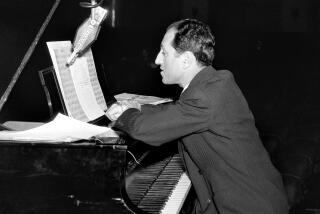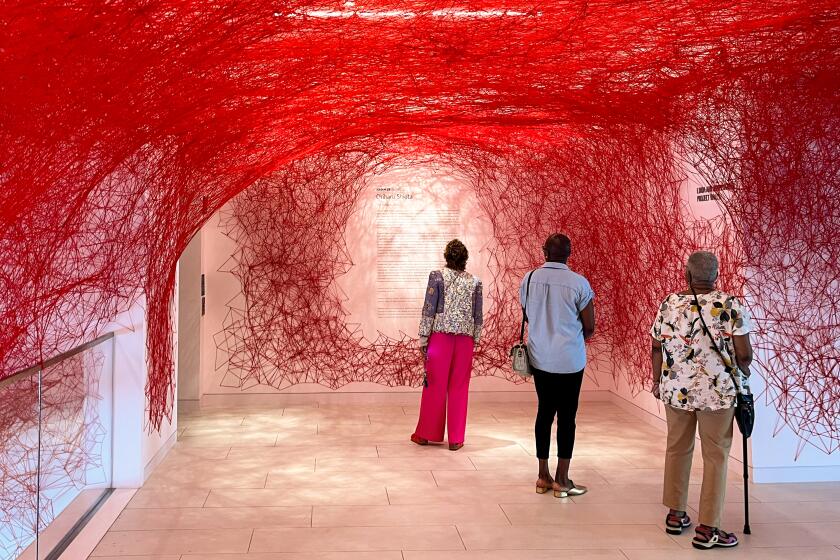Appreciation: How George Crumb became one of America’s most surprisingly consequential composers

George Crumb, who died Sunday at 92, was an all-American composer — one of our best, most original and most important. He was as American as apple pie, this shy, unpretentious West Virginian born in Charleston on Black Thursday, Oct. 24, 1929, the day of the great Wall Street crash. He embraced multiple sides of our contradictory national character through music ethereal yet startling, otherworldly yet stylistically wide-ranging, mysteriously impenetrable yet politically uncompromising, darkly death-obsessed yet marvelously life-affirming.
Crumb may not have been well known outside of new-music circles, but he mattered beyond those perimeters. In 1970 alone, he composed two new pieces that had sweeping implications, continue to resonate and challenge, and sound maybe even more radical and rational now than they did a half-century ago.
One was the string quartet “Black Angels: Thirteen Images From the Dark Land,” written, as Crumb indicated on his graphically arresting score, “in tempore belli (in time of war)” and “Finished Friday the Thirteenth, March 1970.” The Vietnam War raged, and the composer, for the first time in any major string quartet, invoked the horror of modern warfare, exposed the precipitous fall from grace inherent in battle and proposed a path for spiritual redemption.
He asked for the then-new electric string instruments capable of equaling the kinds of galvanizing sparks better associated with Jimi Hendrix. But he also allowed for an amplified quartet that, with enough imaginative virtuosity, might even prove more astounding, as had been the common case. Either way, the quartet begins with “Night of the Electric Insects” and a shock, the aural equivalent of putting your finger in a live socket. The high-pitched sonic torture represents the menace of helicopters over the Vietnam killing fields.
It’s not all pain. The quartet has high-pitched quiet, as well, which is even more intense as you strain to hear it. Old music is quoted, and a sad Baroque sarabande imagined. The string players add bells and gongs and other percussion to the atmosphere. Hints of Schubert’s string quartet “Death and the Maiden” are summoned from the deep recesses of history. Crumb’s catalog of sounds conveys places farther away than Vietnam and as close as our distorted consciousness.
“Black Angels” hit a nerve. William Friedkin used “Electric Insects” in his film “The Exorcist.” David Bowie hailed it. Hearing it on the radio in 1972, the young antiwar violinist David Harrington was driven to form a string quartet for the sole reason of playing it. That was the inception of the Kronos Quartet, which has kept “Black Angels” in its repertoire.
During those 50 years, Kronos has astonishingly commissioned well over 1,000 new string quartets, enticing composers from all over the globe and the genre and stylistic map, proving there is no kind of music that can’t be the province of the string quartet, no moral statement that a string quartet cannot make, no sounds that a string quartet cannot conjure. All thanks to the inspiration and impetus of George Crumb. That alone would have made him a landmark composer.
But that is but a crumb of Crumb. The other propitious work from 1970, and Crumb’s most famous, was “Ancient Voices of Children” for soprano, boy soprano, oboe, mandolin, harp, electric piano and percussion. Intoxicated by Federico García Lorca, Crumb devoted much of his music in the 1960s to unusual settings that accentuated the sheer strangeness of the Spanish poet. He said he was drawn to Lorca’s essential concerns, in all their nuances, with primary things: “life, death, love, the smell of the earth, the sounds of the wind and the sea.”
Crumb boils it down in “Ancient Voices” to our souls and, more important, the soul that exists outside of us. These are our “ancient voices” and at the same time the voices of children. Lorca’s images came to Crumb not from the distinct meaning of his words but their sounds miraculously birthed out of a viscous, changeable atmosphere of primordial sounds.
Again, musical quotes percolate, and more so than in “Black Angels.” Finding new contexts for musical memories in the late 1960s and early ‘70s was on the minds of other major composers, including Duke Ellington in his Sacred Concerts, Leonard Bernstein in “Mass” and Luciano Berio in “Sinfonia.” Whether called Postmodernism or New Romanticism, the sense was that Modernism in music had progressed to such a point that taking stock was necessary before moving on.
Crumb was different. He wasn’t taking stock. He wasn’t Neoclassical or neo-anything. He wasn’t channeling or calling up or reevaluating the past. There is no past, present or future in his music; clock time and historic time are fluid. What is old is not old and what is new is not new. He instead listened to the universes outside and inside of himself and they became one. He didn’t convey emotion, he conveyed awe. The sound of a Lorca-uttered word, the image it called forth, its meaning were not separate. “Ancient Voices” was a revelation and remains one.
Coronavirus may have silenced our symphony halls, taking away the essential communal experience of the concert as we know it, but The Times invites you to join us on a different kind of shared journey: a new series on listening.
Crumb wasn’t exactly a prolific composer, given that his career ranged from the mid-1940s to 2020, but there is nonetheless a good deal of music. He had a noted flair for ritualistic ecology-based chamber music that came from the sea, sky and earth. He turned to the heavens in the ’70s for his astrologically themed grand collection of piano miniatures, “Makrokosmos,” full of imaginative new uses for the keyboard, as original as Chopin and Debussy, whose ghosts looked over Crumb’s shoulder.
Crumb didn’t write a lot for orchestra, but when he did, he went all out. His 1977 “Star-Child,” written for the New York Philharmonic and premiered by Pierre Boulez, is an event that requires, along with a huge orchestra, soprano and trombone soloists, a boys chorus, bell ringers and percussion galore. It needs four conductors. The scale is apocalyptic.
Seven years later, Zubin Mehta led another New York Philharmonic premiere, “The Haunted Landscape.” From a cosmic drone, extraordinary sonic visions emerge of Earth and its peoples. Haunting is a common musical adjective for something weird in the notes that gets under your skin and maybe stays with you. Crumb’s music certainly does that but on a scale unequaled and with a weirdness that feels essential.
That quality could be even more striking meeting Crumb in person. He was a personable Southerner, with an easy sense of humor and a seemingly naive, oh-gosh manner. He was casual. He seemed unflappable. In an engaging video portrait, “Bad Dog,” the composer could come across as utterly ordinary in his shorts and patterned short-sleeve shirt with beloved dogs on his lap. But there he is in his cramped, cluttered, converted-garage studio writing music of the gods, exquisitely crafted, with the flair and skill of a Renaissance draughtsman, the notes on staves forming mathematical and celestial patterns that performers must learn to creatively master. His music of the spheres not only sounds like music of the spheres but looks like it too.
Crumb contentedly spent much of his career living in the Philadelphia suburb of Media and teaching at the University of Pennsylvania. He won a Grammy and a Pulitzer Prize. He had commissions and performances and recordings. He was celebrated but he resisted celebrity. His work has been consistently performed, if not nearly or regularly enough for many of us. Among his champions are Mehta, soprano Dawn Upshaw and pianist Margaret Leng Tan. The record label, Bridge, has taken up the cause with an indispensable “Complete Crumb Edition.”
All in all, Crumb gave the outward appearance of living a contented life. He was a joy to be around. Where the haunting came from, who knows?
But it never left him. In the last decade of the 20th century, he lost his way in his haunted landscapes and wrote little. He then arrived musically and spiritually back home with the new century, producing Crumb-izations of old American songs and spirituals written for his daughter, Broadway singer Ann Crumb. Of course, there was a wealth of percussion.
At the Ojai Festival in 2011, Peter Sellars staged the fourth volume of Crumb’s American Songbook for Upshaw, exposing how a haunted composer’s haunting arrangements of Civil War songs will not stop haunting us. It was shattering.
This was Crumb’s first visit to Ojai, and the last morning of the festival he told me how he discovered Ojai Pixie tangerines. He said he just loved them and wondered how he could bring some home for his wife. I ran across the street to the farmers market and bought him a bag. In exchange, he gave me a copy of his new score and signed it.
Over a beer, I told him I got the better deal by a long shot. With a chuckle and a twinkle in his eye, he implied I still had a lot to learn about Pixies and the cosmos. He was right.
More to Read
The biggest entertainment stories
Get our big stories about Hollywood, film, television, music, arts, culture and more right in your inbox as soon as they publish.
You may occasionally receive promotional content from the Los Angeles Times.








